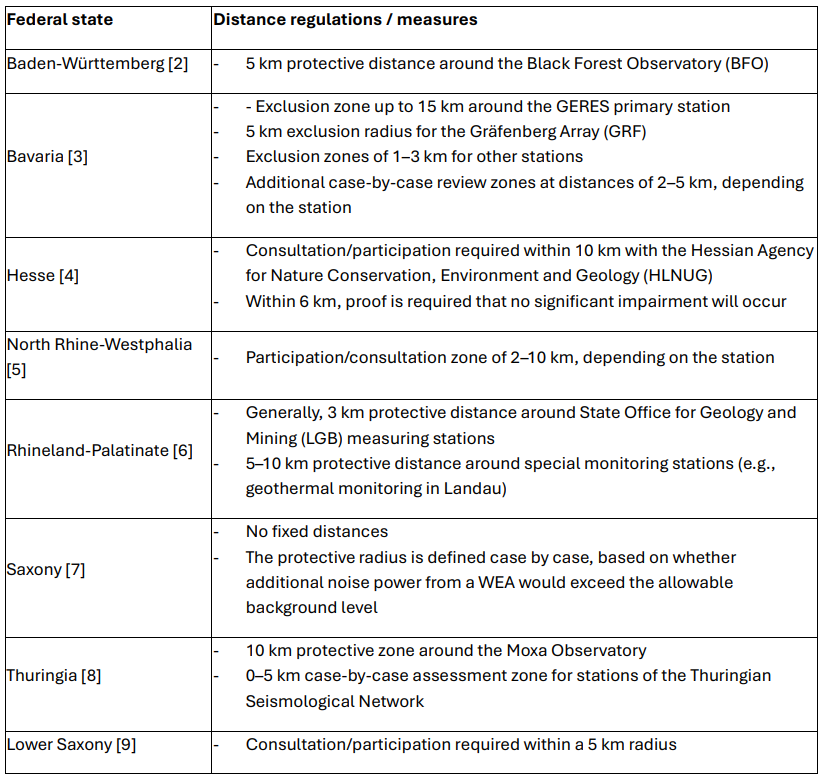Seismological stations as a planning factor for wind energy
In Germany, a dense network of seismological stations continuously records ground movements that are important for earthquake monitoring. Wind turbines can generate similar vibrations and thus distort measurements, which is why many federal states specify protection and testing radii. As these regulations vary from state to state, it is crucial to check the location at an early stage.

The earth does not shake every day in Germany, but when it does, it is recorded by seismographic stations. There is an extensive network of seismological measuring stations operated by various institutions. In addition to the German Regional Seismic Network (GRSN) and the Gräfenberg Seismic Array (GRF Array) of the Federal Institute for Geosciences and Natural Resources (BGR), numerous state services and universities operate their own stations. This multitude of measuring points creates the basis for a sensitive network that continuously records ground disturbances and is used for research, hazard assessment, and safety-related tasks.
How do seismic stations work?
Seismological stations record ground movements caused by seismic waves, such as displacement, velocity, or acceleration. These waves are generated by both natural events such as earthquakes and anthropogenic sources. Measurements are mainly taken using highly sensitive seismometers that utilize the principle of inertia. In applied seismology, geophones are often used for this purpose. A mass mounted on a spring remains largely stationary relative to the housing when vibrations occur. This allows the resulting relative movement to be precisely recorded as a seismic signal. During an earthquake, seismic waves are generated by the fracturing of rock and propagate through the Earth's interior. The strength of the quake can be determined from the measured amplitudes and the distance to the epicenter. The interaction of many stations enables accurate monitoring of seismic activity.
How do wind turbines affect measuring stations?
Wind turbines also cause vibrations in the ground, which are recorded by seismic stations. Wind loads and the movement of the rotor cause vibrations in the tower. These spread through the foundation as seismic waves in the ground. How well they are transmitted depends on the geological subsoil at the location of the turbine and along the propagation path, as well as on the distance between the wind turbine and the measuring station. Since the frequencies generated during the operation of a wind turbine are, depending on the operating mode, in the same range as those that are particularly relevant for earthquake observation, they can distort the recordings of seismographic stations.
What does this mean for wind turbine project developers?
If the distance between a wind turbine and a measuring station is too small, the seismological recordings can be so severely impaired that the station no longer fulfills its purpose in the measuring network. For this reason, many federal states define protection and testing radii within which either no wind turbines may be built or a case-by-case assessment is required to evaluate.
How do the individual federal states handle this?
The federal states have different approaches to how wind turbines should be taken into account in the vicinity of seismic measuring stations. Some specify clear exclusion radii. Others work with the definition of participation or test radii. This means that the operators of the measuring stations are to be informed at an early stage about planned wind farms, while project developers are given the opportunity to comment on potential effects and, if necessary, adjust their plans at an early stage. The following is an overview of the individual distance regulations of the individual federal states. [1]

Criticism of blanket distance regulations
Blanket distance regulations for wind turbines from seismological stations are increasingly being viewed critically. The disruptive effect of wind turbines depends on various factors that go beyond the distance to the measuring point. These include, for example, the type and function of the measuring station, the geological conditions on site, the output of the turbines, and their size. Rigid radii cannot adequately reflect these differences. In addition, there are increasingly innovative ways to reduce interference, such as filtering methods or adapted operating modes. In individual cases, relocating a measuring station may even be a suitable option. There are therefore increasing calls to question blanket minimum distances and replace them with a flexible approach involving case-by-case assessments that take into account the actual conditions on site. Further information can be found in the BWE position paper “Abolish blanket distances to seismological stations and establish case-by-case assessment as standard.” [10]Our solution at dvlpTo make site assessment as easy as possible, we at dvlp clearly display seismological measuring stations in Germany in our Web GIS, including their relevant distance radii. This allows project developers to see whether a planned wind turbine site is within the applicable state regulations.
[1] No general distance rules could be found for Schleswig-Holstein, Saxony-Anhalt, Brandenburg, Berlin, Hamburg, or Bremen.
[2] Pauschalabstände zu seismologischen Stationen abschaffen und Einzelfallprüfung als Standard festlegen (BWE) (31.05.2023) - Link
[3] Hinweise zur Planung und Genehmigung von Windenergieanlagen (WEA) (Windenergieerlass, Ziff. 7.3.4) (31.08.2016) - Link
[4] Genehmigungsverfahren nach dem Bundesimmissionsschutzgesetz: Anleitung zur Erstellung der Antragsunterlagen für Windenergieanlagen (15.01.2020) - Link
[5] Erlass für die Planung und Genehmigung von Windenergieanlagen und Hinweise für die Zielsetzungund Anwendung (Windenergieerlass) (8.05.2018) - Link
[6] WEA vs. seismologischeMessstationen - Herausforderungen und Herangehensweisen (Astrid Stork) (10.11.2023) - Link
[7] WEA vs.seismologische Messstationen - Herausforderungen und Herangehensweisen (AstridStork) (10.11.2023) - Link
[8] Positionspaper: Pauschalabstände zu seismologischen Stationen abschaffen und Einzelfallprüfung als Standard festlegen (BWE) (31.05.2023) - Link
[9] Windenergieerlass (Nds. Ministerialblatt 2021 Nr. 35 S. 1398, Nr. 4.11)
[10] Positionspaper: Pauschalabstände zu seismologischen Stationen abschaffen und Einzelfallprüfung als Standard festlegen (BWE) (31.05.2023) - Link



